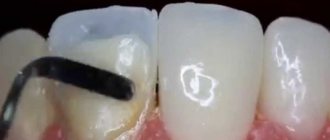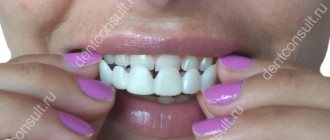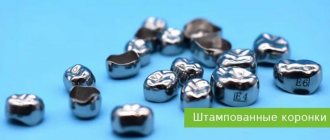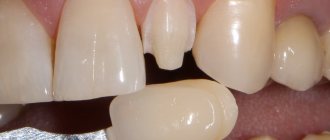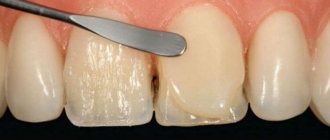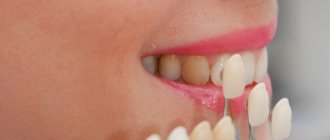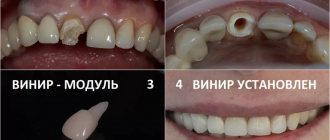Veneers on a refractor are a single frameless structure, which is made of ceramics using a fire-resistant model. Therefore, this type of microprosthetics is often called “fire-resistant restoration.”
In dentistry, a refractor is used not only to restore appearance, but also to strengthen teeth. Ceramics is a rather fragile and non-plastic material. However, after fixation on the surface of the tooth, the refractor plates are tightly connected to the dentin and make the tooth very strong, almost monolithic. This is achieved thanks to other properties of ceramics - hardness, rigidity, porosity, thermal and chemical resistance.
On a note!
Ceramics is one of the most environmentally friendly materials of natural origin.
Why are we the best in the ceramic veneers market?
- our doctors install more than a thousand veneers per year
- own dental laboratory
- we use only imported materials and medicines
- quality control at all stages of treatment
- absolute guarantee on design and work
- we offer veneers from economy class to premium highly artistic ones
- reviews from our patients are better than any words
- promotions and special offers allow you to save significantly
Call and make an appointment by phone 8-800-1000-234
Design features of the refractor
The traditional method of making veneers involves creating a wax model, on the basis of which a solid structure is produced. The front surface of the product replicates natural tooth enamel.
Refractor technology allows you to form a refractory base for the subsequent application of ceramics. The latter is applied in layers, resulting in a very thin structure. The finished form is baked in an oven, after which it is handed over to the dentist for fitting.
Thus, a refractory veneer is a very thin plate that covers the tooth surface and partially covers all its sides. The frameless design is made exclusively from ceramics, and strength is ensured by a fire-resistant base.
What is the difference between composite veneers and ceramic refractor veneers?
Ceramic veneers on a refractor occupy a special position in dentistry due to their unique properties. Only ceramics, unlike composite and glass ionomer materials, have the best aesthetic effect. Composite veneers, even of the highest quality, are essentially plastic. Composite is a material consisting of several components that shrinks and changes color over time. Due to the properties of ceramics and the varied palette of colors used in the process of creating veneers, it is possible to achieve ideal accuracy in conveying the color and shape of the tooth.
Only with the help of ceramic veneers on a refractor can you achieve a natural shade and natural light transmission. All-ceramic veneers do not lose their natural shine, they are strong and durable, do not stain over time and retain their original shape and texture.
Modern veneers in dentistry
Thick plates requiring serious tooth grinding are almost a thing of the past. A modern veneer is a very thin plate of durable ceramic, the thickness of which does not exceed 0.2-0.4 millimeters. Some veneers are almost as thick as eye contact lenses. Such a small thickness was achieved thanks to improved ceramic masses, which are highly durable. Now even a very thin veneer will not crack, unless, of course, you try to chew on a glass bottle or a piece of concrete.
Most often, veneers are classified as aesthetic dentistry because they allow you to perfectly adjust the color and shape of your teeth. However, veneer, being a microprosthesis, also solves functional problems - to hide chips and cracks in the enamel, to remove slightly enlarged spaces between teeth, to hide pigment spots. The veneer also serves as protection for the tooth, since ceramics are not subject to abrasion, unlike tooth enamel. It is much more difficult for plaque and bacteria to gain a foothold on ceramics.
Installing veneers can also significantly rejuvenate the face - they will restore the height of the teeth, like in young people, and will serve as a framework for the soft tissues of the face, which to a certain extent will prevent the appearance of wrinkles and sagging skin. However, if conventional veneers are so successful in the aesthetic and functional restoration of a smile, then why are refractor veneers needed?
Can a ceramic veneer made with a refractor crack or break?
After manufacturing, ceramic veneers on the refractor are a thin plate. It looks like a translucent scale of a given color.
Of course, if the veneer is dropped or hit with a heavy object, it will crack and break. But, as soon as the doctor attaches this thin plate to the tooth with a special photopolymer composition, the veneer and tooth form a strong, monolithic connection. According to its technical characteristics, a ceramic veneer on a refractor is harder than tooth enamel. The use of veneers does not require any special conditions. The only restriction is not to test their strength and not to crack nuts with your teeth, not to chew through the wire and not to open bottles. Heavy loads can lead to chipping of your own tooth and detachment, compromising the integrity of the ceramic veneer.
Refractor in dentistry - what is it?
In the usual production of veneers, doctors first create a wax model of the teeth, and then dental technicians use pressing or milling to create a solid veneer, the front surface of which imitates natural tooth enamel.
When using a refractor, a refractory base is first formed from a special material, and the dental technician applies ceramics to it in layers, forming a very thin plate. Then the entire structure is baked in an oven, after which it is handed over to the doctor so that the patient can try on the resulting veneer.
So, when answering the question “refractor veneers - what are they?” we can say that this is a very thin plate, in addition to the front surface of the tooth, slightly covering the side edges and the cutting edge. In fact, it is frameless and metal-free ceramics, the strength of which is imparted by a fire-resistant base.
Differences between veneers created using a refractor and conventional ones:
- strengthening teeth - after installation, the refractor plates are tightly connected to the surface of the tooth, which makes the structure very strong, almost monolithic, in contrast to pressed or milled plates, which remain rigid and non-plastic;
- increased strength - they are almost not susceptible to chipping or other damage, even if you like very hard food;
- minimal grinding due to minimal thickness - and sometimes you can even do without tooth preparation. Some clinics claim that they can make a ceramic veneer on a refractor with a thickness of 0.1–0.2 millimeters;
- almost no preparation is required - often it is enough to treat the enamel with a special compound and fix the veneers.
Can teeth be treated after installing ceramic veneers?
Before installing ceramic veneers, the doctor must examine the patient’s oral cavity and carry out the necessary procedures: treats caries, removes plaque, whitens teeth. If caries subsequently occurs on the tooth with the veneer installed, treatment is carried out and a filling is installed. Also, after installing ceramic veneers, in order to extend the life of the plates, it is necessary to regularly carry out professional comprehensive cleaning of the oral cavity.
Refractor or pressed ceramic veneers – which is better?
There are practically no differences between these types, the only difference is in the way they are installed. It is the treatment that determines the further quality and aesthetics of the restored teeth.
To create pressed ceramic veneers, a wax-up method is used. First, a model-cast is made from special wax, onto which a ceramic plate is pressed under high pressure. On one of its sides the anatomical features of the enamel coating of the teeth are “imprinted”. The advantage of the method is the accurate transfer of existing irregularities and grooves on the inside of the veneer adjacent to the tooth.
The advantage of refractory veneers is the ability to install them with a minimum grinding of 0.2 - 0.4 mm or without it at all. They are very thin and allow you to achieve the best results in terms of aesthetics. Such microprostheses are ideal for the restoration of anterior teeth when it is necessary to correct the shape or color.
On a note!
For the patient, it does not matter exactly how and what the veneers are made of. The appearance and quality of tooth “repair” depends entirely on the qualifications of the orthopedist and dental technician. This can be compared to painting a picture, when a child and a professional artist paint with the same colors - the result will be completely different. When choosing a technique, the dentist is guided by the condition of the oral cavity and teeth to be veneered.
The average price of a veneer using a refractor is 18,000 – 20,000 rubles, but this figure can be significantly higher or lower.
Manufacturing stages
The main differences between fireproof veneers and regular veneers are the way the slabs are created. The main task of dental technicians is to produce a ceramic plate that more accurately conveys all the characteristics of the tooth on which it will be fixed, in order to achieve an ideal fit. Without these conditions, the veneer cannot be securely and effectively installed on the tooth.
When creating a viri with a refractor, everything happens a little differently, although the initial stages of the formation of microprostheses are similar:
- The orthopedic surgeon photographs the patient's teeth and takes an impression. This is necessary for 3D modeling of a future smile;
- diagnostic wax-up – creating a wax-up model for veneers so that the patient can try it on and evaluate the result. In addition, fittings and wax models are needed so that the doctor can get a more accurate idea of the existing dental defects; this is important to consider when creating veneers;
- if necessary, preparation or rotation of teeth, during which the doctor removes a minimum layer of tooth enamel. However, in some cases, when creating veneers using a refractor, repairs can be avoided;
- if the teeth are still turned out, the doctor installs temporary veneers on them to protect the teeth from external influences;
- creation of permanent veneers - the formation of a fire-resistant base, followed by layer-by-layer application of ceramic mass and firing;
- Before fixing to the teeth, the finished veneers are etched and washed with a special solution to achieve a strong connection with the front surface of the tooth;
- installation of permanent veneers using dental cement.
Installing veneers is a lengthy process that requires patience and several visits to the clinic. It takes 1 to 3 weeks to produce the plates in a dental laboratory. As a result, the entire process from the first visit to an orthopedic dentist to the fixation of finished veneers can take about a month.
Characteristics of veneers on refractors
- Strengthening enamel. The plates are fixed to the tooth surface, resulting in a durable, monolithic structure. Unlike analogues made using alternative technologies, refractors have plasticity and optimal rigidity.
- They are resistant to increased mechanical stress, which minimizes the risk of chips and cracks when biting through hard food.
- They practically do not require turning due to their minimal thickness. Sometimes the preparatory stage can be missed. According to some clinics, the thickness of veneers can be no higher than 0.2 mm.
- Easy installation. To fix it, it is enough to treat the surface of the tooth with a special agent.
Manufacturing
Refractory veneers differ from traditional ones mainly in their manufacturing technology. The refractor plate is made in maximum accordance with the characteristics of the tooth, which ensures precise fixation. This is a prerequisite for reliable fixation.
The initial stages of creating a refractory structure intersect with the formation of traditional microprosthetic designs:
- the orthopedist makes an impression of the patient’s teeth for subsequent 3-D modeling;
- Wax models are created for the patient to try on. This step allows you to evaluate the planned result in advance. Wax models allow the doctor to create an accurate clinical picture and identify dental defects, which is important for working with veneers;
- If necessary, preparation is carried out by removing a small layer of enamel with a drill. Modern technologies make it possible to skip this stage;
- if preparation is carried out, then temporary structures are installed for the patient to protect the tooth until permanent veneers are installed;
- permanent veneers are created. A refractory base is formed, onto which a ceramic composition is applied in layers. The model is then baked;
- Before installation, veneers are treated with a special compound that ensures strong adhesion to the tooth surface;
- The veneers are fixed with special cement.
Installation is a labor-intensive process that takes place over several visits to the dental office. It takes 1-3 weeks to manufacture the design. If you are just planning to install veneers, you will be able to enjoy the results after a month.
